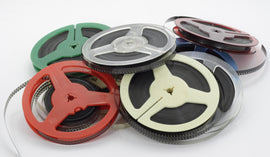
The cassette tape, small plastic audio reels encased in a protective plastic shell, revolutionized the music industry in the 1970s and 1980s. The compact size and portability of the cassette tape made it possible for people to listen to their favorite music on the go. The standard size cassette tape, which measured 4.875 inches by 2.5 inches, quickly became the go-to format for music lovers around the world.
The cassette tape was invented by Lou Ottens, the director of product development for the Dutch electronics company Philips, in 1963. Ottens was inspired by the desire for a more convenient way to listen to music, and the cassette tape was his solution. The first commercially available cassette tapes were released by Philips in August of 1964 and were called "Compact Cassettes." They were an immediate success, and by the 1970s, the cassette tape had surpassed the 8-track tape as the most popular format for portable music.
One of the key benefits of the cassette tape was its versatility. Unlike the 8-track tape, which could only play music, the cassette tape could be used to record anything with a microphone. This made the cassette tape a popular choice for journalists, who used it to record interviews, and for musicians, who used it to record demos. The ease of recording and copying music onto cassette tapes also made it possible for musicians to distribute their music independently, bypassing the traditional music industry distribution channels.
The cassette tape also changed the way people listened to music. Before the cassette tape, most people listened to music on the radio or on vinyl records. The cassette tape made it possible for people to create their own personal playlists, choosing the songs they wanted to listen to and the order in which they wanted to hear them. This was a major shift from the passive listening experience of the past, and it allowed people to take control of their own musical experiences.
The popularity of the cassette tape reached its peak in the late 1970s and early 1980s, with the rise of the "mixtape." The mixtape was a compilation of songs recorded onto a cassette tape, often by a person for someone they cared about. The act of creating a mixtape was seen as a personal and thoughtful gesture, and the mixtape itself was seen as a physical representation of the relationship between the giver and the receiver. The mixtape became a cultural icon and a symbol of love and friendship.
However, by the late 1980s and early 1990s, the cassette tape was facing increasing competition from new technologies, such as the compact disc (CD) and the digital audio tape (DAT). The CD offered improved sound quality, and the DAT offered the ability to record digital audio, making it possible to produce higher-quality recordings. As a result, the cassette tape's popularity declined. All were eventually overtaken by digital audio files like FLAC and MP3.
Today, the cassette tape is largely a thing of the past, and it is only used by a small niche of collectors and enthusiasts. However, its legacy lives on, and its impact on the music industry and popular culture cannot be overstated. The cassette tape allowed people to listen to music on the go, and it made it possible for people to create their own personal playlists and take control of their musical experiences. It also allowed musicians to distribute their music independently and opened up new avenues for artistic expression. The cassette tape may be gone, but its influence will be felt for generations to come.
The standard size cassette tape was a groundbreaking invention that changed the way people listened to music and created new opportunities for artists. Its portability, versatility, and affordability made it a popular format for decades, and its impact on popular culture and the music industry is still felt today. While the cassette tape has been largely replaced by newer technologies, its legacy remains as a symbol of a bygone era and a reminder of the creative and cultural possibilities that it unlocked. In a world where technology is constantly evolving, the standard size cassette tape serves as a reminder of how a simple invention can have a lasting impact on the world.
Select a box to get started.
Each includes all materials & shipping.
Pack whatever fits, no need to sort.
Drop off at any UPS Store.







